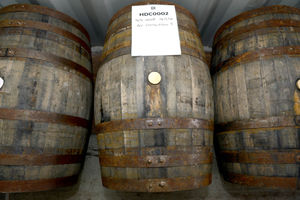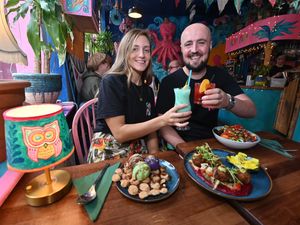We can’t wait to have a sip! We visit Oswestry gin and whisky distillery
There are two key ingredients that all whisky producers need in abundance – time and patience.

This is because the highly-coveted drink is one that simply refuses to be rushed.
“It has to mature in a wooden barrel for three years before it’s allowed to be classed as whisky. It also gets most of its unique taste from the casks it is being matured in.
“Once the whisky has been bottled, it does not improve so the maturation time is very important when making whisky,” Chris Toller, of Henstone Distillery in Oswestry.
And he is the man in the know because he is currently facing a long wait for three oak casks of the distillery’s first malt whisky to be ready.
“We filled our first cask on January 10 this year so on January 11, 2021 it will be whisky. It’s a long time to wait but we believe it will be worth it,” Chris, who works at Stonehouse Brewery where the distillery is based, tells us.

Henstone joins a growing number of distilleries popping up all over the UK with latest figures showing there are now 315 – more than double the number operating five years ago.
And in the same way as craft beers have enjoyed a surge in popularity, whisky has also been attracting new fans. “There seems to be a lot of interest in whisky now and with more distilleries opening, there is more choice for the customer.
“For us making whisky was a logical step because we already had all of the beer making equipment we needed,” he tells us.
Process
All whisky begins life as beer and the process starts with letting the barley germinate until the starch of the grain has become malt sugar.
Hot water is added to extract the sugar and the resulting liquid is then left to ferment, producing a beer without the addition of hops. But don’t pour yourself a glass just yet. “It’s very strong and not particularly nice tasting so you wouldn’t want to sample it,” Chris, who is one of four directors of Henstone alongside his wife Alex and brewery owners Shane and Alison Parr, tells us.
Next it’s pumped into the 1,000-litre still, affectionately named Hilda, which has been manufactured by Kothe in Eislingen, near Stuttgart in Germany and enables the team to produce about 600 bottles per run.
The distillation process sees the liquid being heated and the condensed vapour being split into three parts. The first called the heads contains a high proportion of methanol and can be highly volatile. “It doesn’t smell particularly nice and doesn’t taste pleasant so you know this isn’t what you want,” explains Chris.
Hearts
What every whisky producer wants is the hearts, this is the spirit that has all the right components - taste, smell and alcohol content – to become whisky.
The last 60 to 70 litres of the run is known as the tails and this is weak tasting and not so full in flavour as the hearts. “The first 40 litres of the tails may still be nice so that will go back into the next run. The whole whisky run takes about 10 hours,” says Chris.
Before it goes into the ex-bourbon and new American oak barrels, the ‘new make spirit’, which is about 83 per cent ABV is diluted with pure water to around 65% ABV.
Now the team has to wait to taste the fruits of their labour. “It’s a long-term investment and there is a risk involved. All four directors of Henstone are agreed that we are not going to sell anything that we don’t like so if we’re not happy with it, it’s not going on sale and will be left to mature for as long as it needs. But we are confident that in three years time we will have a quality whisky because all of the signs so far have been good,” says Chris.
And they have been given an early boost by selling out of the first batch of 200 bottles. “We started selling ‘futures’, which entitled the owner to a uniquely numbered bottle from the first batch of Henstone Distillery whisky and we were delighted when they all sold out,” says Chris.
Gin time
While they wait for their whisky to become, well, whisky, they have also been busy making another on-trend drink – gin.
“Originally we weren’t going to make gin, we were just going to make whisky and other drinks from the raw ingredients we already had. But when we went on a trip to Eislingen to visit the manufacturer of the still, we had the opportunity to sample some gin.
“We were so impressed that we made a deal for the recipe. We have now tweaked it a little to make it unique to us. We did have to do a fair amount of sampling to make sure it was right. We were worried we might be a little too late for gin and that it’s popularity might have wavered but it still seems to be on the up,” says Chris.

The exact recipe is a close-guarded secret but it contains eight different botanicals, such as coriander and cardamom together with the juniper, which has to be the predominant taste for it to be classed as gin.
“The feedback we have received so far has been amazing and we are so proud of the product we have produced. It has some secret ingredients and really packs a punch. It’s also a bit unusual because when it goes cold or is mixed with cold drinks, it goes cloudy which is known as a louche and is caused by the oils separating.
“At first we panicked and tried to filter it but we didn’t like the end result so we decided to leave it because it doesn’t alter the taste at all. People seem to find it interesting and it’s become a selling point,” says Chris.
Following the success of their gin, the team are even more excited for 2021 when their highly-anticipated whisky will have matured. “We are dying to take a sip.”





